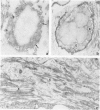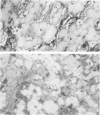Abstract
The effect of DL-penicillamine on the architecture of the aortic wall of growing chickens was studied, with particular attention to elastin and collagen. Penicillamine was added to the diet (0.2% and 0.4%, in the presence or not of 10 mg/kg CuSO4 and 100 mg/kg vitamin B6) from hatching, for periods from 7 days up to 2 months. The same regions of the thoracic aortas were examined and compared in all the different experimental conditions. The results showed that penicillamine induced relevant modifications in the process of elastin fibrogenesis. The alterations consisted of an increase of elastin in the extracellular space, associated with an increase in the number of elastin fibers per unit area, and a decrease of the mean profile area of the fibers. Interestingly, penicillamine induced the formation of numerous bundles of microfibrils associated or not with elastin fibers. After prolonged treatment, elastin tended to diminish and the fibers tended to fuse into polymorphic syncytia. Collagen fibrils were larger, showed more heterogeneous cross diameters, were less numerous, and were more spread out within the tissue. All the other components of the aortic wall appeared not to be altered by the chemical. Penicillamine did not modify the copper content of chick aortas, whereas it induced a 40-50% reduction of the activity of both salt and 4 M urea-soluble peptidyl lysyl oxidases in the same tissue. These data may help in understanding some of the pathologic manifestations in human beings during D-penicillamine treatment.
Full text
PDF











Images in this article
Selected References
These references are in PubMed. This may not be the complete list of references from this article.
- Aronow R., Brege B., Chen H. Y., Smith R. G. The influence of oral penicillamine and diet on lead poisoning in rats. Clin Toxicol. 1977 Sep;11(2):221–235. doi: 10.3109/15563657708989835. [DOI] [PubMed] [Google Scholar]
- Arrigoni-Martelli E., Binderup L. D-penicillamine, lymphocytes, and macrophages: an account of experimental investigations in vivo. J Rheumatol Suppl. 1981 Jan-Feb;7:62–68. [PubMed] [Google Scholar]
- Bird T. A., Levene C. I. Lysyl oxidase: evidence that pyridoxal phosphate is a cofactor. Biochem Biophys Res Commun. 1982 Oct 15;108(3):1172–1180. doi: 10.1016/0006-291x(82)92124-6. [DOI] [PubMed] [Google Scholar]
- Braverman I. M. The role of blood vessels and lymphatics in cutaneous inflammatory processes: an overview. Br J Dermatol. 1983 Jul;109 (Suppl 25):89–98. [PubMed] [Google Scholar]
- Bucknall R. C., Balint G., Dawkins R. L. Myasthenia associated with D-penicillamine therapy in rheumatoid arthritis. Scand J Rheumatol Suppl. 1979;(28):91–93. doi: 10.3109/03009747909108245. [DOI] [PubMed] [Google Scholar]
- Burres S. A., Richman D. P., Crayton J. W., Arnason B. G. Penicillamine-induced myasthenic responses in the guinea pig. Muscle Nerve. 1979 May-Jun;2(3):186–190. doi: 10.1002/mus.880020306. [DOI] [PubMed] [Google Scholar]
- Charlebois G., Cadotte M., Barbeau A. Cutis hyperelastica après administration prolongée de pénicillamine chez une patiente atteinte de maladie de Wilson. Union Med Can. 1972 May;101(5):893–895. [PubMed] [Google Scholar]
- Contri M. B., Fornieri C. C., Ronchetti I. P. Elastin-proteoglycans association revealed by cytochemical methods. Connect Tissue Res. 1985;13(3):237–249. doi: 10.3109/03008208509152403. [DOI] [PubMed] [Google Scholar]
- DU VIGNEAUD V., KUCHINSKAS E. J., HORVATH A. L-penicillamine and rat liver transaminase activity. Arch Biochem Biophys. 1957 Jul;69:130–137. doi: 10.1016/0003-9861(57)90480-0. [DOI] [PubMed] [Google Scholar]
- Deshmukh K., Nimni M. E. A defect in the intramolecular and intermolecular cross-linking of collagen caused by penicillamine. II. Functional groups involved in the interaction process. J Biol Chem. 1969 Apr 10;244(7):1787–1795. [PubMed] [Google Scholar]
- Dobryszycka W., Owczarek H. Effects of lead, copper, and zinc on the rat's lactate dehydrogenase in vivo and in vitro. Arch Toxicol. 1981 Aug;48(1):21–27. doi: 10.1007/BF00297072. [DOI] [PubMed] [Google Scholar]
- Foster J. A., Rich C. B., Fletcher S., Karr S. R., DeSa M. D., Oliver T., Przybyla A. Elastin biosynthesis in chick embryonic lung tissue. Comparison to chick aortic elastin. Biochemistry. 1981 Jun 9;20(12):3528–3535. doi: 10.1021/bi00515a035. [DOI] [PubMed] [Google Scholar]
- Glatt H., Oesch F. Mutagenicity of cysteine and penicillamine and its enantiomeric selectivity. Biochem Pharmacol. 1985 Oct 15;34(20):3725–3728. doi: 10.1016/0006-2952(85)90237-0. [DOI] [PubMed] [Google Scholar]
- Harris E. D., Rayton J. K., DeGroot J. E. A critical role for copper in aortic elastin structure and synthesis. Adv Exp Med Biol. 1977;79:543–559. doi: 10.1007/978-1-4684-9093-0_45. [DOI] [PubMed] [Google Scholar]
- Hill C. H., Kim C. S. The derangement of elastin synthesis in pyridoxine deficiency. Biochem Biophys Res Commun. 1967 Apr 7;27(1):94–99. doi: 10.1016/s0006-291x(67)80045-7. [DOI] [PubMed] [Google Scholar]
- Junker P., Helin G., Lorenzen I. Effect of D-penicillamine on collagen, glycosaminoglycans, DNA and RNA of granulation tissue and connective tissue of skin, bone and aorta in rats. Acta Pharmacol Toxicol (Copenh) 1981 Apr;48(4):300–310. doi: 10.1111/j.1600-0773.1981.tb01625.x. [DOI] [PubMed] [Google Scholar]
- Junker P., Helin G., Lorenzen I. Effect of different doses of D-penicillamine and combined administration of D-penicillamine and methylprednisolone on collagen, glycosaminoglycans, DNA and RNA of granulation tissue, skin, bone and aorta in rats. Acta Pharmacol Toxicol (Copenh) 1981 Nov;49(5):366–380. doi: 10.1111/j.1600-0773.1981.tb00918.x. [DOI] [PubMed] [Google Scholar]
- Kagan H. M., Hewitt N. A., Salcedo L. L., Franzblau C. Catalytic activity of aortic lysyl oxidase in an insoluble enzyme-substrate complex. Biochim Biophys Acta. 1974 Sep 13;365(1):223–234. doi: 10.1016/0005-2795(74)90267-0. [DOI] [PubMed] [Google Scholar]
- Kang B., Veres-Thorner C., Heredia R., Cha E., Bose S., Schwartz M. Successful treatment of far-advanced progressive systemic sclerosis by D-penicillamine. J Allergy Clin Immunol. 1982 Mar;69(3):297–305. doi: 10.1016/s0091-6749(82)80007-9. [DOI] [PubMed] [Google Scholar]
- Keeley F. W. The synthesis of soluble and insoluble elastin in chicken aorta as a function of development and age. Effect of a high cholesterol diet. Can J Biochem. 1979 Nov;57(11):1273–1280. doi: 10.1139/o79-169. [DOI] [PubMed] [Google Scholar]
- Keiser H. R., Henkin R. I., Kare M. Reversal by copper of the lathyrogenic action of D-penicillamine. Proc Soc Exp Biol Med. 1968 Nov;129(2):516–522. doi: 10.3181/00379727-129-33359. [DOI] [PubMed] [Google Scholar]
- Kim C. S., Hill C. H. The interrelationship of dietary copper and amine oxidase in the formation of elastin. Biochem Biophys Res Commun. 1966 Aug 12;24(3):395–400. doi: 10.1016/0006-291x(66)90171-9. [DOI] [PubMed] [Google Scholar]
- Meyrick Thomas R. H., Light N., Stephens A. D., Avery N. C., Kirby J. D. Pseudoxanthoma elasticum-like skin changes induced by penicillamine. J R Soc Med. 1984 Sep;77(9):794–798. doi: 10.1177/014107688407700917. [DOI] [PMC free article] [PubMed] [Google Scholar]
- Miller E. J., Martin G. R., Mecca C. E., Piez K. A. The biosynthesis of elastin cross-links. The effect of copper deficiency and a lathyrogen. J Biol Chem. 1965 Sep;240(9):3623–3627. [PubMed] [Google Scholar]
- Murray J. C., Fraser D. R., Levene C. I. The effect of pyridoxine deficiency on lysyl oxidase activity in the chick. Exp Mol Pathol. 1978 Jun;28(3):301–308. doi: 10.1016/0014-4800(78)90004-7. [DOI] [PubMed] [Google Scholar]
- Nimni M. E. A defect in the intramolecular and intermolecular cross-linking of collagen caused by penicillamine. I. Metabolic and functional abnormalities in soft tissues. J Biol Chem. 1968 Apr 10;243(7):1457–1466. [PubMed] [Google Scholar]
- Nimni M. E., Bavetta L. A. Collagen defect induced by penicillamine. Science. 1965 Nov 12;150(3698):905–907. doi: 10.1126/science.150.3698.905. [DOI] [PubMed] [Google Scholar]
- Nimni M. E., Deshmukh K., Gerth N., Bavetta L. A. Changes in collagen metabolism associated with the administration of penicillamine and various amino and thiol compounds. Biochem Pharmacol. 1969 Apr;18(4):707–714. doi: 10.1016/0006-2952(69)90041-0. [DOI] [PubMed] [Google Scholar]
- Otomo S., Takeshita K., Koda H., Ohzeki M. [Studies of D-penicillamine (4) : effects on antibody formation (author's transl)]. Nihon Yakurigaku Zasshi. 1981 Jul;78(1):45–56. [PubMed] [Google Scholar]
- Pasquali-Ronchetti I., Bressan G. M., Fornieri C., Baccarani-Contri M., Castellani I., Volpin D. Elastin fiber-associated glycosaminoglycans in beta-aminopropionitrile-induced lathyrism. Exp Mol Pathol. 1984 Apr;40(2):235–245. doi: 10.1016/0014-4800(84)90080-7. [DOI] [PubMed] [Google Scholar]
- Pasquali-Ronchetti I., Fornieri C., Castellani I., Bressan G. M., Volpin D. Alterations of the connective tissue components induced by beta-aminopropionitrile. Exp Mol Pathol. 1981 Aug;35(1):42–56. doi: 10.1016/0014-4800(81)90006-x. [DOI] [PubMed] [Google Scholar]
- Pass F., Goldfischer S., Sternlieb I., Scheinberg I. H. Elastosis perforans serpiginosa during penicillamine therapy for Wilson disease. Arch Dermatol. 1973 Nov;108(5):713–715. [PubMed] [Google Scholar]
- Pinnell S. R., Martin G. R. The cross-linking of collagen and elastin: enzymatic conversion of lysine in peptide linkage to alpha-aminoadipic-delta-semialdehyde (allysine) by an extract from bone. Proc Natl Acad Sci U S A. 1968 Oct;61(2):708–716. doi: 10.1073/pnas.61.2.708. [DOI] [PMC free article] [PubMed] [Google Scholar]
- Pool K. D., Feit H., Kirkpatrick J. Penicillamine-induced neuropathy in rheumatoid arthritis. Ann Intern Med. 1981 Oct;95(4):457–458. doi: 10.7326/0003-4819-95-4-457. [DOI] [PubMed] [Google Scholar]
- Rayton J. K., Harris E. D. Induction of lysyl oxidase with copper. Properties of an in vitro system. J Biol Chem. 1979 Feb 10;254(3):621–626. [PubMed] [Google Scholar]
- Rodnan G. P. Progressive systemic sclerosis and penicillamine. J Rheumatol Suppl. 1981 Jan-Feb;7:116–120. [PubMed] [Google Scholar]
- Ronchetti I. P., Contri M. B., Fornieri C., Quaglino D., Jr, Mori G. Alterations of elastin fibrogenesis by inhibition of the formation of desmosine crosslinks. Comparison between the effect of beta-aminopropionitrile (beta-APN) and penicillamine. Connect Tissue Res. 1985;14(2):159–167. doi: 10.3109/03008208509015021. [DOI] [PubMed] [Google Scholar]
- Ross R. The elastic fiber. J Histochem Cytochem. 1973 Mar;21(3):199–208. doi: 10.1177/21.3.199. [DOI] [PubMed] [Google Scholar]
- Ross R. The smooth muscle cell. II. Growth of smooth muscle in culture and formation of elastic fibers. J Cell Biol. 1971 Jul;50(1):172–186. doi: 10.1083/jcb.50.1.172. [DOI] [PMC free article] [PubMed] [Google Scholar]
- Rumsby P. C., Shepherd D. M. The effect of penicillamine on vitamin B6 function in man. Biochem Pharmacol. 1981 Nov 15;30(22):3051–3053. doi: 10.1016/0006-2952(81)90492-5. [DOI] [PubMed] [Google Scholar]
- Siegel R. C. Collagen cross-linking. Effect of D-penicillamine on cross-linking in vitro. J Biol Chem. 1977 Jan 10;252(1):254–259. [PubMed] [Google Scholar]
- Siegel R. C. Lysyl oxidase. Int Rev Connect Tissue Res. 1979;8:73–118. doi: 10.1016/b978-0-12-363708-6.50009-6. [DOI] [PubMed] [Google Scholar]
- Steen V. D., Medsger T. A., Jr, Rodnan G. P. D-Penicillamine therapy in progressive systemic sclerosis (scleroderma): a retrospective analysis. Ann Intern Med. 1982 Nov;97(5):652–659. doi: 10.7326/0003-4819-97-5-652. [DOI] [PubMed] [Google Scholar]
- Tandon S. K., Behari J. R., Singh S. Chelation in metal intoxication XI: effect of thiol chelators on lead poisoned rabbits. Res Commun Chem Pathol Pharmacol. 1981 Jun;32(3):557–560. [PubMed] [Google Scholar]
- Volpin D., Pasquali-Ronchetti I., Castellani I., Giro M. G., Peserico A., Mori G. Ultrastructural and biochemical studies on a case of elastosis perforans serpiginosa. Dermatologica. 1978;156(4):209–223. doi: 10.1159/000250919. [DOI] [PubMed] [Google Scholar]
- WALSHE J. M. Treatment of Wilson's disease with penicillamine. Lancet. 1960 Jan 23;1(7117):188–192. doi: 10.1016/s0140-6736(60)90109-4. [DOI] [PubMed] [Google Scholar]
- Wassef M., Galian A., Pepin B., Haguenau M., Vassel P., Hautefeuille P., Brazy J. Unusual digestive lesions in a patient with Wilson's disease treated with long-term penicillamine. N Engl J Med. 1985 Jul 4;313(1):49–49. doi: 10.1056/nejm198507043130114. [DOI] [PubMed] [Google Scholar]
- Williams D. R., Halstead B. W. Chelating agents in medicine. J Toxicol Clin Toxicol. 1982 Dec;19(10):1081–1115. doi: 10.3109/15563658208992544. [DOI] [PubMed] [Google Scholar]






